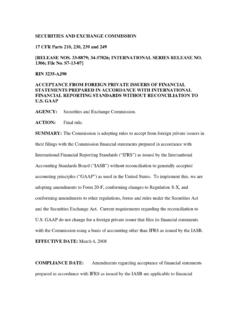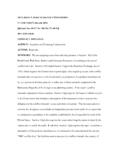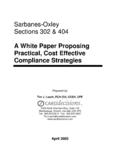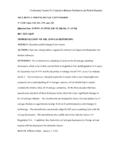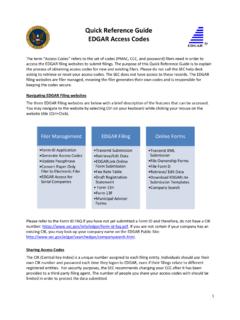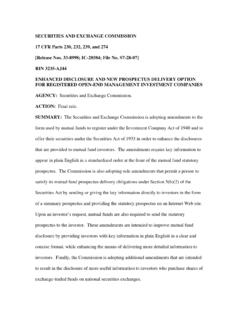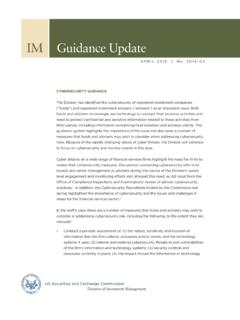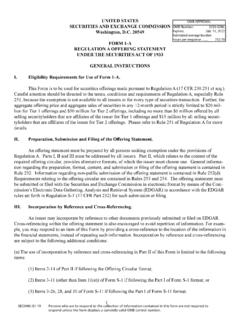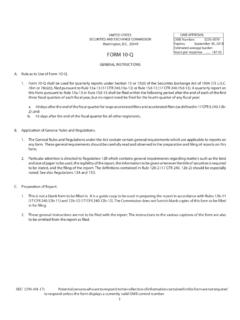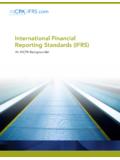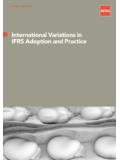Transcription of Staff Paper: A Comparison of U.S. GAAP and IFRS
1 Work Plan for the Consideration of Incorporating international financial reporting standards into the financial reporting System for Issuers A Comparison of gaap and ifrs A Securities and Exchange Commission Staff Paper November 16, 2011 OFFICE OF THE CHIEF ACCOUNTANT UNITED STATES SECURITIES AND EXCHANGE COMMISSION This is a paper by the Staff of the Securities and Exchange Commission. The Commission has expressed no view regarding the analysis, findings, or conclusions contained herein. TABLE OF CONTENTS I.
2 II. A. Scope of the B. MoU and Other Joint C. SEC Rules and Regulations ..8 D. General Observations and Clarifications ..8 III. Comparison of Requirements ..11 A. Accounting Changes and Error Corrections ..11 B. Earnings Per C. Interim reporting ..14 D. Risks and E. Segment F. Cash and Cash G. Other Investments ..18 H. I. Other Assets and Deferred Costs ..21 J. K. Property, Plant, and Equipment ..24 L. Liabilities ..26 M. Asset Retirement and Environmental Obligations ..26 N. Exit or Disposal Cost O. Commitments ..30 P. Q. R. S. Compensation Excluding Share-based Payments.
3 34 T. Stock Compensation ..37 U. Other Expenses ..39 V. Research and W. Income Taxes ..42 X. Business Y. Foreign Currency Matters and Inflation ..45 Z. Nonmonetary Transactions ..47 AA. Related Party Disclosures ..48 BB. CC. Subsequent Events ..49 I. Introduction In the Commission Statement in Support of Convergence and Global Accounting standards ,1 the Securities and Exchange Commission ( SEC or Commission ) directed the Staff of the Office of the Chief Accountant of the SEC, with consultation with other Divisions and Offices of the Commission (collectively, Staff or we ), to develop and execute a work plan ( Work Plan ).
4 2 The Work Plan was published in February 2010. The purpose of the Work Plan is to consider specific areas and factors relevant to a Commission determination as to whether, when, and how the current financial reporting system for issuers should be transitioned to a system incorporating international financial reporting standards ( ifrs ).3 The Work Plan is divided into six areas of focus. The first area involves an assessment of whether there is sufficient development and application of ifrs for the domestic reporting system. This area was designed to respond to Commission statements that, in further considering ifrs , it would need to consider whether those accounting standards are of high quality and sufficiently comprehensive 4 and that [a] necessary element for a set of global accounting standards .
5 Is that they must be high-quality .. 5 The Commission has described high-quality standards as requiring consistent, comparable, relevant and reliable information that is useful for investors, lenders and creditors, and others who make capital allocation decisions. 6 In the Work Plan, the Staff noted that its evaluation of the sufficient development and application of ifrs would include inventorying areas in which ifrs does not provide guidance or where it provides less guidance than gaap . The manner in which the Staff intended to perform the inventory was further explained in the Staff s October 2010 Progress Report7 as an analysis of the text of ifrs as issued by the IASB as compared to the text of gaap .
6 In this paper, the Staff summarizes the results of its analysis. 1 See SEC Release No. 33-9109 (Feb. 24, 2010), Commission Statement in Support of Convergence and Global Accounting standards ( 2010 Statement ). 2 The Work Plan is included as an appendix to the 2010 Statement. 3As used in this Staff Paper, the term ifrs refers to ifrs as issued by the international Accounting standards Board ( IASB ), unless otherwise noted. Further, the term ifrs refers to the authoritative text of ifrs , which, according to the ifrs Foundation Constitution, is published in English. See international financial reporting standards (IFRSs) as issued at 1 January 2010, Preface to international financial reporting standards .
7 The IASB is the international Accounting standards Board. IFRSs refers to more than one international financial reporting Standard. 4 See SEC Release No. 33-8982 (Nov. 14, 2008) [73 FR 70816 (Nov. 21, 2008)], Roadmap for the Potential Use of financial Statements Prepared in Accordance with international financial reporting standards by Issuers. 5 2010 Statement. 6 See SEC Release No. 33-7801 (Feb. 16, 2000) [65 FR 8896 (Feb. 23, 2000)], international Accounting standards ( 2000 Concept Release ). 7 See Securities and Exchange Commission, Office of the Chief Accountant and Division of Corporation Finance, Work Plan for the Consideration of Incorporating international financial reporting standards into the financial reporting System for Issuers, Progress Report (October 29, 2010).
8 1 II. Methodology The Staff used a comparative approach to provide a context in which to frame its evaluation of ifrs , rather than to establish a minimum threshold of development that must be met for the incorporation of ifrs into the financial reporting system for issuers. The Staff used gaap specifically as its reference point because: (1) it is the body of standards that currently applies to issuers and from which investors would be required to adjust their analyses of issuers financial statements, and (2) it enables the Staff to minimize its consideration of areas in which ifrs currently has the same or similar accounting requirements as gaap , as those ifrs requirements are presumably of sufficiently high As a result, our review was focused on identifying areas in which the requirements of ifrs and gaap differ.
9 This review did not include an analysis of the impact that those differences, individually or collectively, may have on the quality of ifrs . A. Scope of the Analysis The Staff reviewed gaap accounting requirements and compared those requirements to equivalent or corresponding ifrs requirements, as applicable. The Staff omitted from its review any gaap requirements and the ifrs equivalents that are subject to the ongoing joint standard-setting efforts either through the Memorandum of Understanding ( MoU ) joint standard-setting projects ( Joint Projects ) of the FASB and the IASB (together with the FASB, the Boards ) or other efforts by the Boards to work together, as further explained below.
10 9 Having excluded the areas of gaap and ifrs subject to the ongoing Joint Projects, we analyzed the remaining gaap Accounting standards Codification ( ASC ) Topics and their corresponding or equivalent ifrs requirements. This paper summarizes our observations at a principles level for each ASC Topic that we evaluated. We then supplement those high-level observations with more specific examples of differences between gaap and ifrs . The differences discussed do not comprise a comprehensive population of differences. We endeavored to provide examples that we believe could have a more significant or widespread financial reporting impact.
